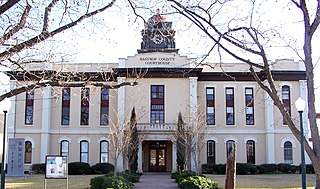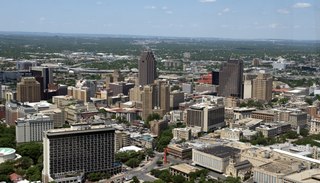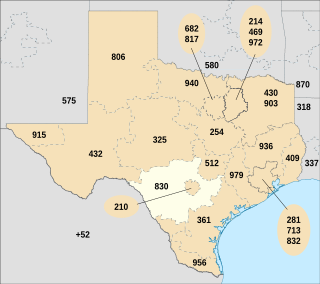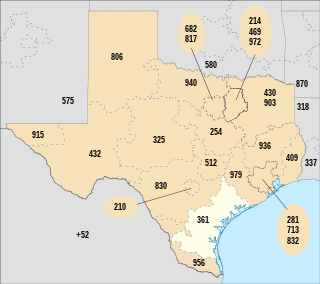
Travis County is located in Central Texas. As of the 2020 census, the population was 1,290,188. It is the fifth-most populous county in Texas. Its county seat and most populous city is Austin, the capital of Texas. The county was established in 1840 and is named in honor of William Barret Travis, the commander of the Republic of Texas forces at the Battle of the Alamo. Travis County is part of the Austin–Round Rock–Georgetown Metropolitan Statistical Area. It is located along the Balcones Fault, the boundary between the Edwards Plateau to the west and the Blackland Prairie to the east.

Bastrop County is located in the U.S. state of Texas. It is in Central Texas and its county seat is Bastrop.

Bastrop is a city and the county seat of Bastrop County, Texas, United States. The population was 9,688 according to the 2020 census. It is located about 30 mi (48 km) southeast of Austin and is part of the Greater Austin metropolitan area.

Corpus Christi is a coastal city in the South Texas region of the U.S. state of Texas and the county seat and largest city of Nueces County with portions extending into Aransas, Kleberg, and San Patricio counties. It is 130 miles (210 km) southeast of San Antonio and 208 miles (335 km) southwest of Houston. Its political boundaries encompass Nueces Bay and Corpus Christi Bay. Its zoned boundaries include small land parcels or water inlets of three neighboring counties.

Whataburger is an American regional fast food restaurant chain, headquartered and based in San Antonio, Texas, that specializes in hamburgers. Founded by Harmon Dobson and Paul Burton, it opened its first restaurant in Corpus Christi, Texas in 1950. Family-owned by the Dobsons until 2019, the chain is now managed by the private equity firm BDT & MSD Partners; the Dobson family still holds a small stake.

Corpus Christi International Airport is 6 miles west of Corpus Christi, in Nueces County, Texas. It opened in 1960, replacing Cliff Maus airport at 27.767°N 97.44°W, where the Lozano Golf Center is now located.

South Texas is a region of the U.S. state of Texas that lies roughly south of—and includes—San Antonio. The southern and western boundary is the Rio Grande, and to the east it is the Gulf of Mexico. The population of this region is about 4.96 million according to the 2017 census estimates. The southern portion of this region is often referred to as the Rio Grande Valley. The eastern portion along the Gulf of Mexico is also referred to as the Coastal Bend.

H-E-B Grocery Company, LP, is an American privately held supermarket chain based in San Antonio, Texas, with more than 380 stores throughout the U.S. state of Texas and Mexico. The company also operates Central Market, an upscale organic and fine foods retailer. As of 2022, the company had a total revenue of US$38.9 billion. H-E-B ranked number 6 on Forbes' 2022 list of "America's Largest Private Companies". The company also ranked number 3 on Forbes' 2024 list of "Customer Experience All-Stars." H-E-B was named Retailer of the Year in 2010 by Progressive Grocer. Supermarket News ranks H-E-B 13th on the list of "Top 75 North American Food Retailers" by sales. Based on 2019 revenues, H-E-B is the 19th-largest retailer in the United States. It donates 5% of pretax profits to charity. The official mascot of H-E-B is named H-E-Buddy, an anthropomorphic brown grocery bag, with multiple grocery items emerging from the top.

Brownsville/South Padre Island International Airport is 5 miles east of downtown Brownsville, Cameron County, Texas.

Area codes 210 and 726 are telephone area codes in the North American Numbering Plan (NANP) for the San Antonio area in the U.S. state of Texas. Area code 210 was created in an area code split from number plan area 512 in 1992. After only a few years, the threat of number exhaustion forced a reduction of the size of the numbering plan area to the center of the San Antonio metropolitan area in 1997. Area code 726 was assigned to the same numbering plan area in an overlay complex activated in 2017 to alleviate the threat of exhaustion of central office codes that was expected by 2018. Area codes 210 and 726 are enclave codes for an area completely surrounded by numbering plan area 830.

Area codes 214, 469, 972, and 945 are telephone area codes in the North American Numbering Plan (NANP) for Dallas, Texas and most of the eastern portion of the Dallas–Fort Worth metroplex. The area codes are assigned in an overlay complex to a single numbering plan area that was the core of one of the original area codes of 1947, area code 214.

Area code 830 is the telephone area code in the North American Numbering Plan (NANP) for the Texas Hill Country and most of San Antonio's suburbs. It completely surrounds area codes 210 and 726, which serve most of San Antonio itself along with its innermost suburbs.

North American area code 361 is a state of Texas telephone area code for numbers in the Corpus Christi area, the Coastal Bend and the Victoria Crossroads. It was created prior to February 13, 1999, in a split from area code 512.

The Austin–Round Rock–San Marcos metropolitan statistical area, or Greater Austin, is a five-county metropolitan area in the U.S. state of Texas, as defined by the Office of Management and Budget. The metropolitan area is situated in Central Texas on the western edge of the American South and on the eastern edge of the American Southwest, and borders Greater San Antonio to the south.

The Laredo National Bank (LNB) was a Texas bank founded in 1892 headquartered in Laredo, Texas which was bought by Banco Bilbao Vizcaya Argentaria. LNB had been a component in the development of business and industry along the United States-Mexico border and South Texas. The Laredo National Bank had grown to approximately $3.5 billion in assets and was the fifth largest independent bank in Texas. Headquartered in Laredo, Texas, LNB had branches in Austin, Brownsville, Corpus Christi, Dallas, Del Rio, Eagle Pass, Harlingen, Houston, McAllen, San Antonio, San Marcos, and Weslaco. Laredo National Bank owned South Texas National Bank. Laredo National Bank's branches and headquarters names have been changed to Compass Bank on November 14, 2008 due to a merger between Laredo National Bank Compass and BBVA. BBVA Compass plans on cutting 170 jobs and eliminating the Laredo National Bank headquarters.

Corpus Christi is a coastal city in the South Texas region of the U.S. state of Texas. The county seat of Nueces County, it also extends into Aransas, Kleberg, and San Patricio counties. The population was 277,454 at the 2000 census; in 2006 the U.S. Census Bureau estimated the city's population at 285,175, making it the eighth-largest city in the state. It is the principal city of the three-county Corpus Christi Metropolitan Statistical Area as well as the larger Corpus Christi-Kingsville Combined Statistical Area. The translation from Latin of the city's name is Body of Christ, given to the settlement by the Spanish, in honor of the Blessed Sacrament (Eucharist). The city has been nicknamed The Sparkling City by the Sea, or "Corpitos" particularly in literature promoting tourism.

Central Texas is a region in the U.S. state of Texas roughly bordered on the West by San Saba to the Southeast by Bryan and the South by San Marcos to the North by Hillsboro. Central Texas overlaps with and includes part of the Texas Hill Country and corresponds to a physiographic section designation within the Edwards Plateau, in a geographic context.

The Texas Triangle is a region of Texas that contains the state's five largest cities and is home to the majority of the state's population. The Texas Triangle is formed by the state's four main urban centers, Austin, Dallas-Fort Worth, Houston, and San Antonio, connected by Interstate 45, Interstate 10, and Interstate 35. In 2020, the population of the Texas Triangle reached nearly 21 million following rapid growth across much of Texas. The Texas Triangle is one of eleven megaregions in the United States, clusters of urban areas that share economic and cultural ties.

The U.S. state of Texas has a series of estuaries along its coast on the Gulf of Mexico, most of them bounded by the Texas barrier islands. Estuaries are coastal bodies of water in which freshwater from rivers mixes with saltwater from the sea. Twenty-one drainage basins terminate along the Texas coastline, forming a chain of seven major and five minor estuaries: listed from southwest to northeast, these are the Rio Grande Estuary, Laguna Madre, the Nueces Estuary, the Mission–Aransas Estuary, the Guadalupe Estuary, the Colorado–Lavaca Estuary, East Matagorda Bay, the San Bernard River and Cedar Lakes Estuary, the Brazos River Estuary, Christmas Bay, the Trinity–San Jacinto Estuary, and the Sabine–Neches Estuary. Each estuary is named for its one or two chief contributing rivers, excepting Laguna Madre, East Matagorda Bay, and Christmas Bay, which have no major river sources. The estuaries are also sometimes referred to by the names of their respective primary or central water bodies, though each also includes smaller secondary bays, inlets, or other marginal water bodies.



















